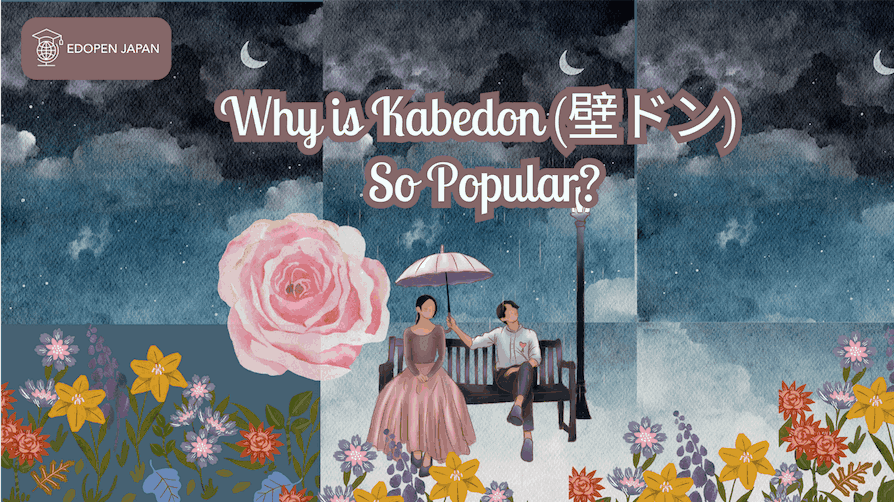Romance is not to be forgotten among the many interesting cultures Japan has to offer. Japan has many different unwritten cultures regarding love and love confessions.
If you are an anime lover or J-drama fanatic, kabedon is probably not a foreign word in your vocabulary. Kabedon is a fairly common image painted in many romance manga found in Japan.
Contents
Kabedon (壁ドン): What is it?

So, what is Kabedon? Is it a rice bowl?
’Kabe’ means wall and ‘don’ is related to the sound of slapping or banging in Japanese (not a rice bowl, unfortunately). Put them together, and we get something in the context closely related to wall banging or slapping.
Or more accurately to describe Kabedon is the action of hitting or slamming something against the wall that makes a “don” sound.
A single image of a couple and a wall
Kabedon (壁ドン) Source: www.ac-illust.com

In the context of manga and anime, kabedon is often associated with the act of a male character pinning a female character to the wall in an act of love confession. This act of kabedon often makes the reader’s or viewer’s heart race.
In addition, if you are currently learning other interesting Japanese phrases that are often used in everyday conversation in Japan, please read our recommendations below:
See also:
The Meaning of Yabai (やばい)
What’s the Meaning of “Sasuga” (さすが)?
History of Kabedon (壁ドン)
Now that we’ve covered the meaning and context of where Kabedon is usually seen, let’s look a little deeper into the history of Kabedon.
Kabedon made its first appearance in 2008, where it was described as a “lovely situation”. This act was later popularized by shojo manga Ayu Watanabe’s L DK and Hiro Fujiwara’s Maid Sama!, who began using Kabedon regularly in their artwork.
Types of Kabedon (壁ドン)
Before we delve deeper into this topic, let’s get a few things straight. Kabedon is often thought of as a love language, but it can also be used to show power superiority in non-romantic scenarios.
In action manga, kabedon is used by the character to intimidate and show dominance over the other character who is pinned to the wall. In this scenario, the character is venting and showing his frustration and anger by slamming the other character against the wall as a confrontational act.
The other type is the much more typical type mentioned above, in an act of love. This is often seen in romance manga, where a character is often pinned to the wall by the love interest as an act of love. The ideal scenario would be for the female character to eventually take an interest in the male character who confessed his love through this act of love: Kabedon.
Why is Kabedon (壁ドン) So Popular?

While kabedon may be a part of Japanese culture, it may be foreign to many other cultures, especially those that have no kabedon practice at all.
How did Kabedon gain so much popularity since 2008?
Dating back to some of the popular anime that have expressed Kabedon through love confessions, they show the character as direct and unafraid to express their love, which fortunately ends with the other character accepting the love and turning into a happy ending. Most of these famous anime scenes were then turned into memes, which are still incredibly popular today.
The act of Kabedon is dressed as cool. Coolness from the male character’s dominance and romantic side. It shows the male character’s commitment and seriousness in his love interest. It also expresses the male character’s leadership and toughness that allows the female to believe and learn that trust and compatibility with such character.
It may seem cool and attractive to some, but it may not be the same for everyone. In the world of anime and manga, this act of love may be highly accepted, but in real life it may not be. Some may find this act creepy or rather intimidating and scary. Some may even prefer a softer and gentler approach to a confession of love. This act of love may even lead to awkwardness or worse, an act of sexual harassment.
It is safe to say that Kabedon is often best described as a fantasy of male dominance and female submission. It may work for some, but not for everyone. And, it doesn’t always happen in every love confession scene in real life!
Different Ways to Express Kabedon (壁ドン)

The classic way of Kabedon is the one arm pose. It can be cool with one arm against the wall and the other in the pocket. The classic move.
Two arms pinned to the side can be used to enhance the confession and make it much more intimate. With this pose you can express your love to the fullest.
The other way, instead of using the arms, is to use a leg as a kabedon. The higher the leg the better, but this method can be extremely dangerous and difficult to pull off. Often used as a parody and seen in some anime by the girl character who asserts dominance through this method.
Modern Day Kabedon (壁ドン)
Although it may be a popular act of love in manga and anime, is it really practiced in real life these days? Let’s just say we want to keep it in anime and manga.
As mentioned before, it can be viewed favorably by some as a sign of good compatibility, but it can also be viewed unfavorably. It is a difficult path to cross. There are many other ways to make a confession or show an act of love in today’s society.
Since Japanese culture is rather refined and not so straightforward in the love chapter, kabedon is one way to go, but so are small gestures like giving flowers.
Dating strategies do not begin and end with Kabedon.
Summary
- Now that we have covered the main aspects of Kabedon, an art of love confession in Japan, the main question is, “Is this the best way to express love?
- I will leave that up to you, but keep in mind that while it may be popular in Japan, it may not be so around the world.
I hope this article has given you a clearer picture of what Kabedon is. Sometimes I feel sorry for the walls that have been “damaged” in the process of Kabedon. See you next time!













